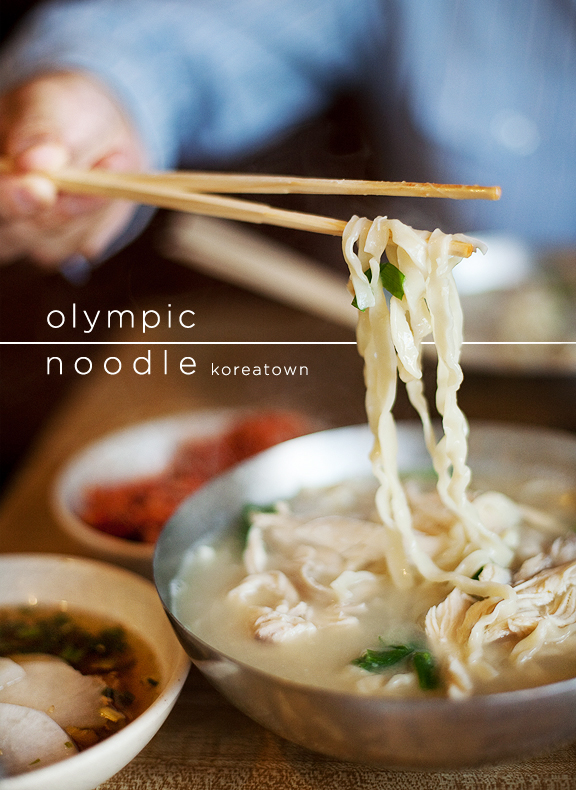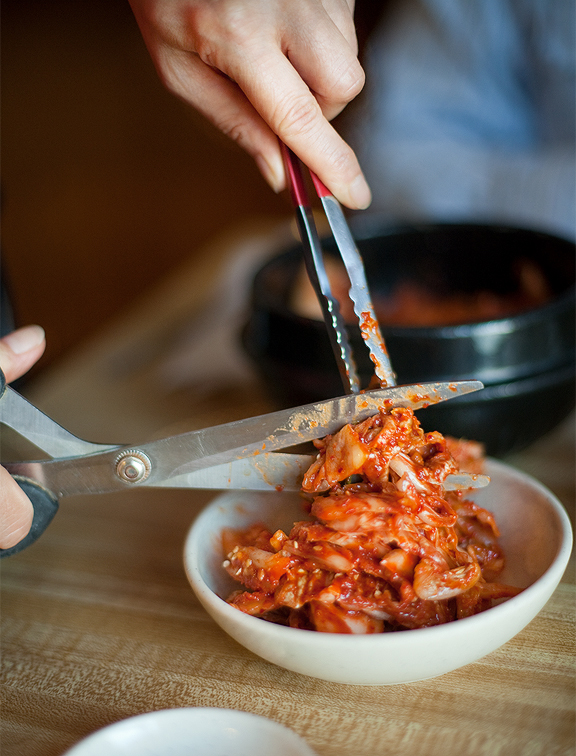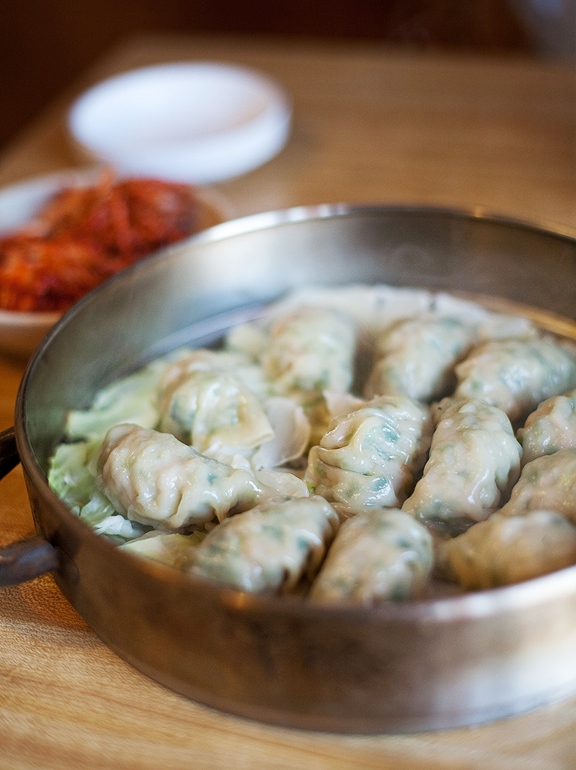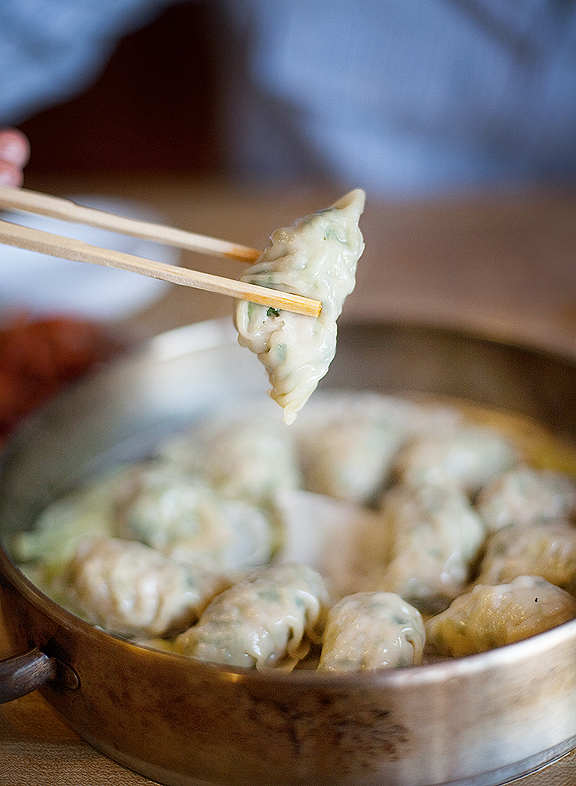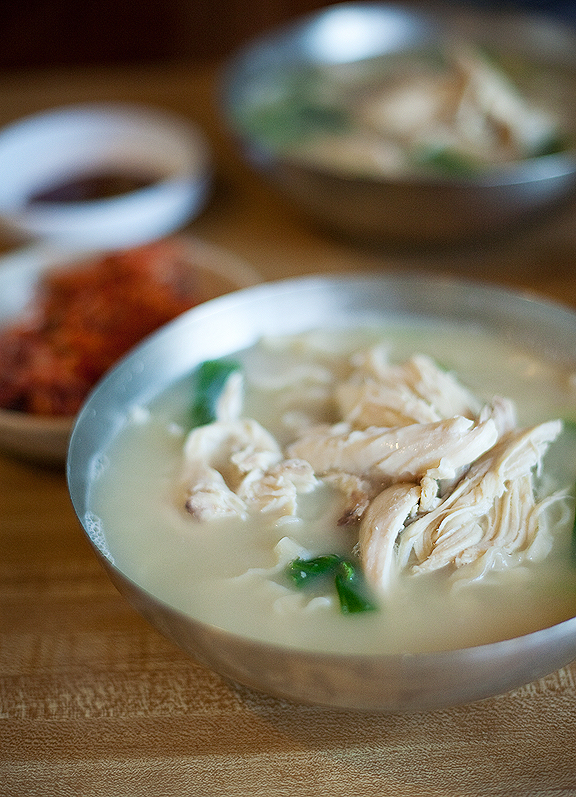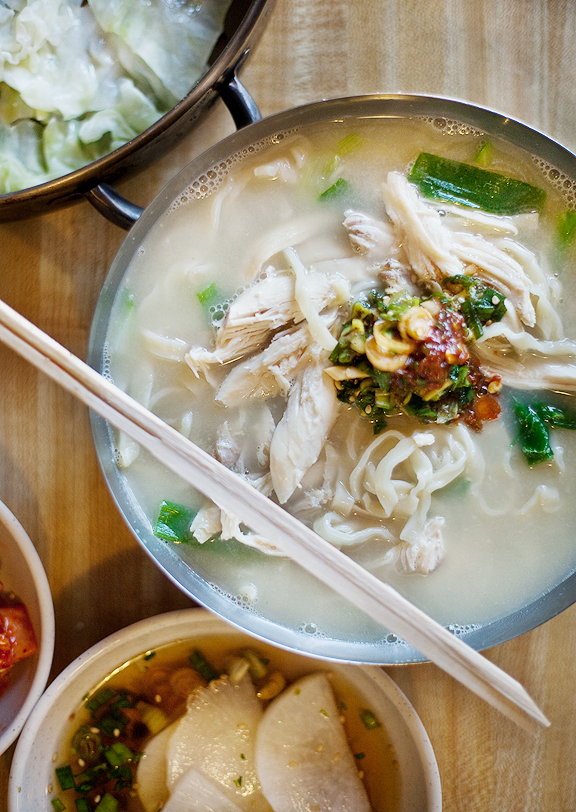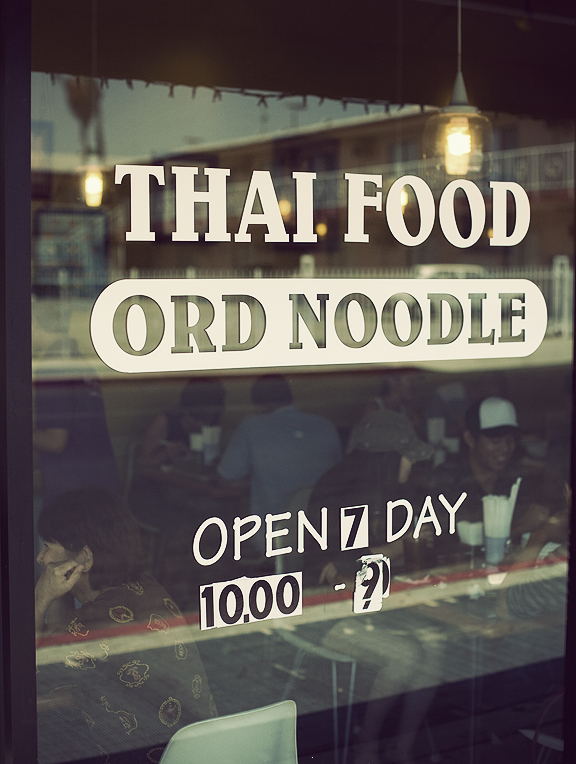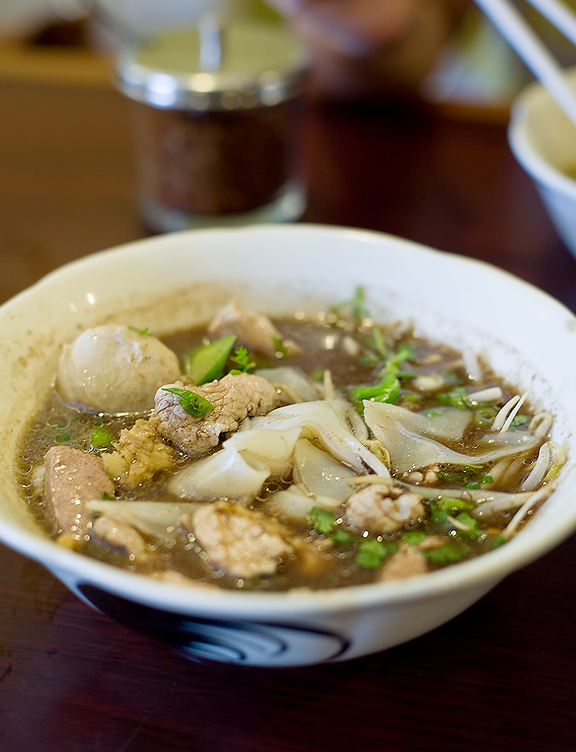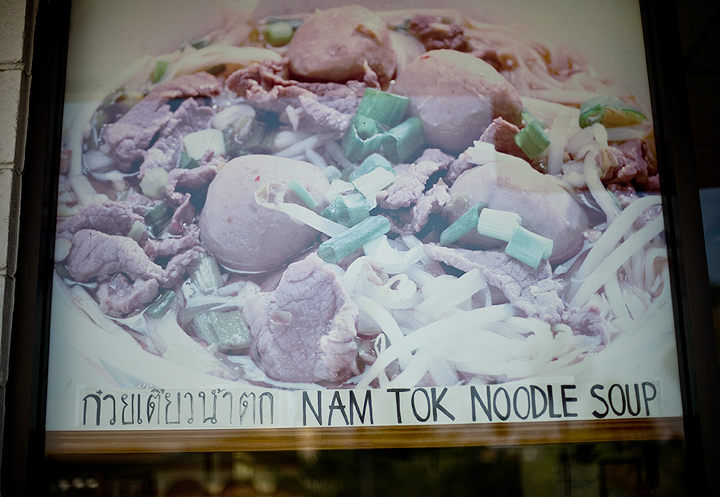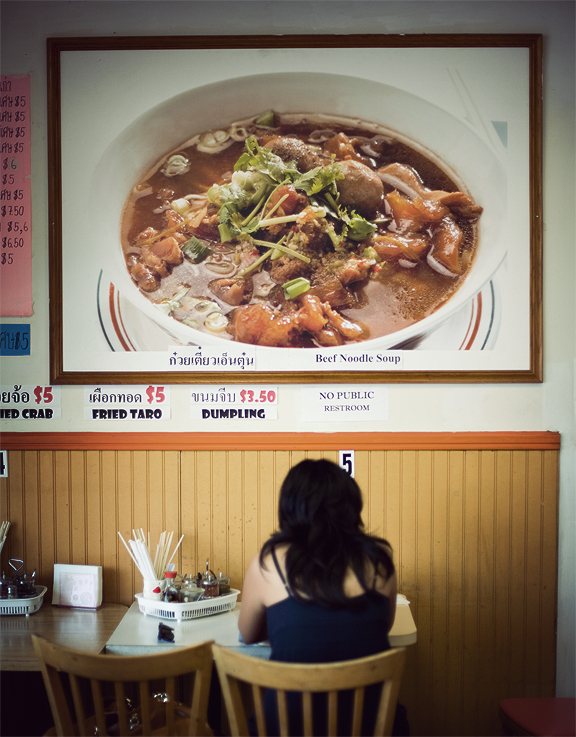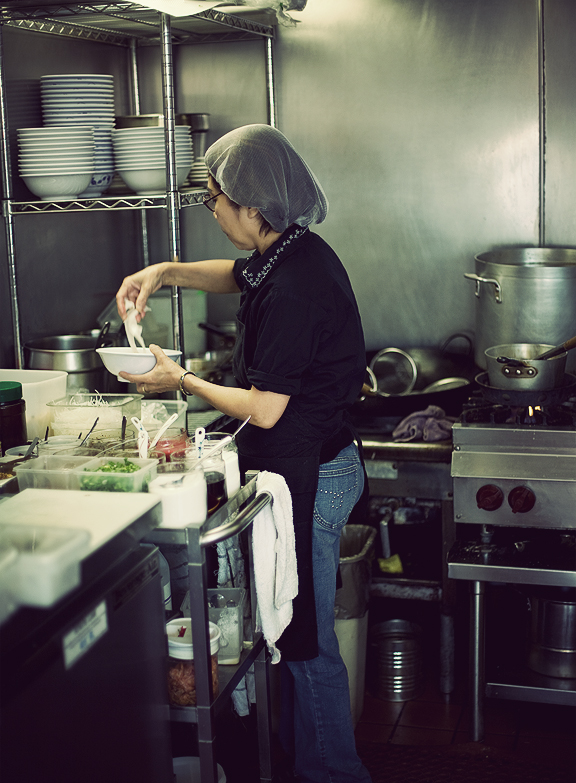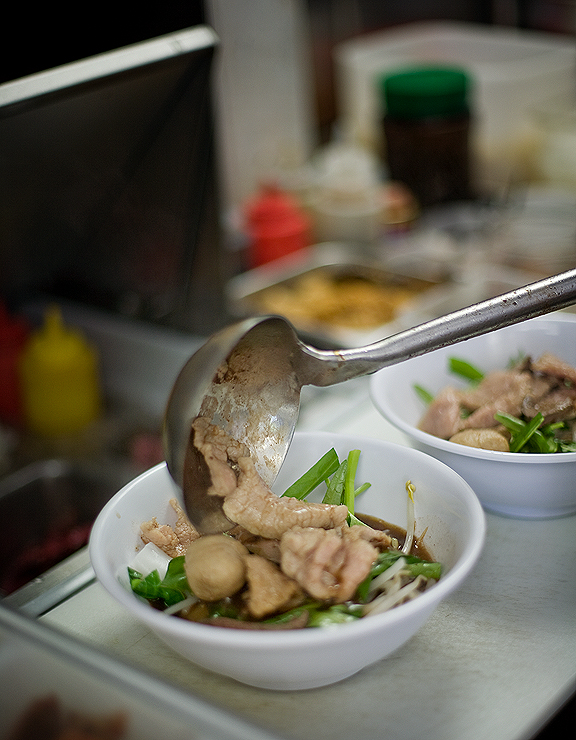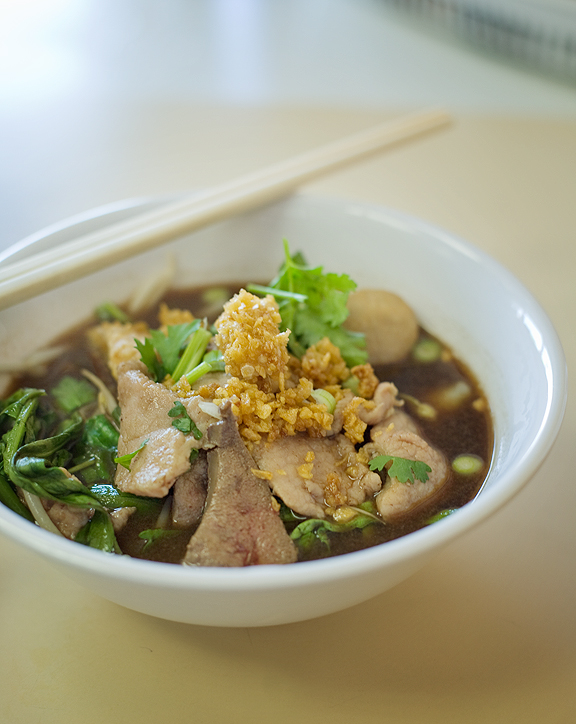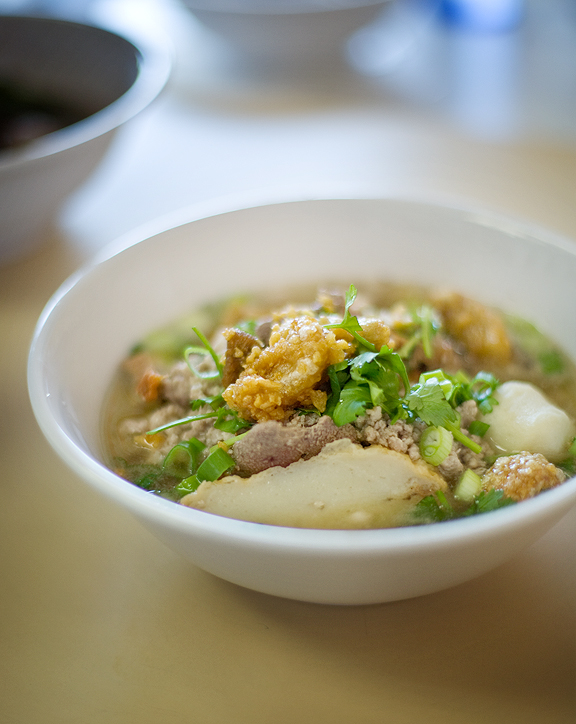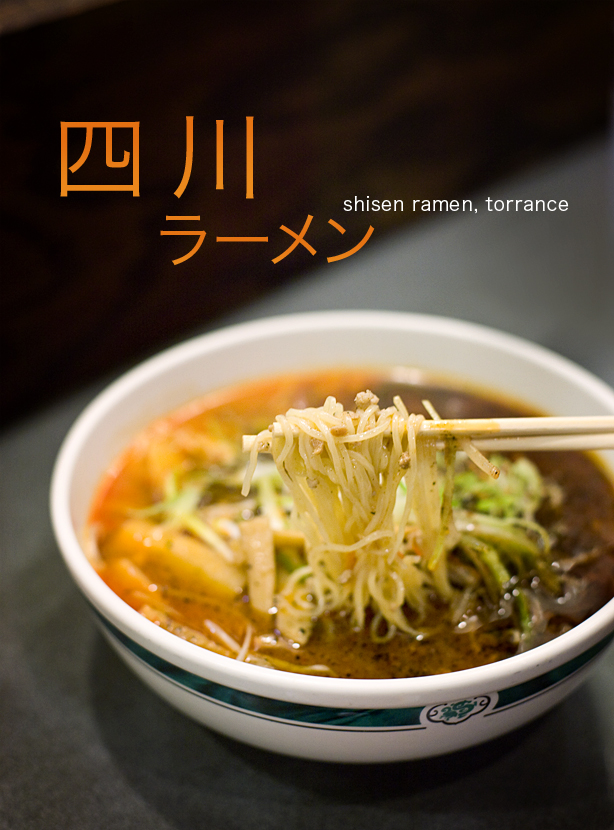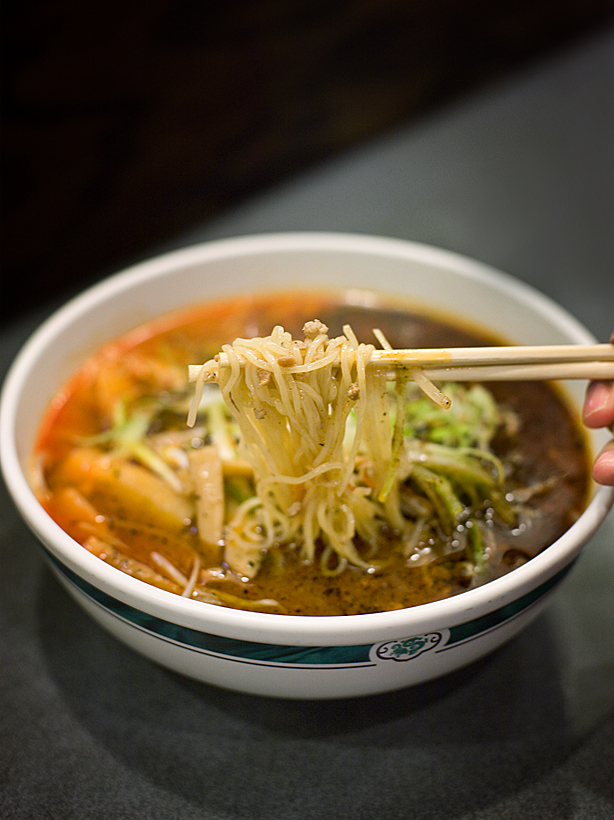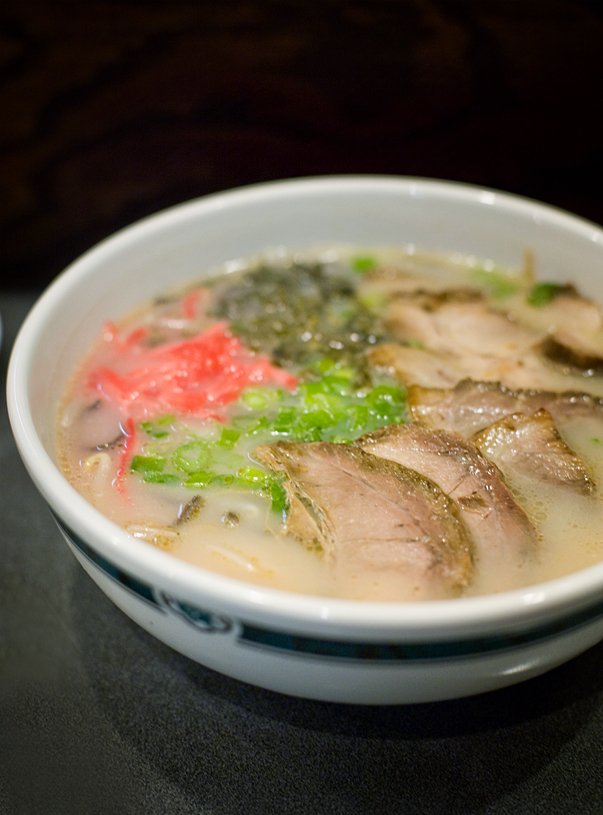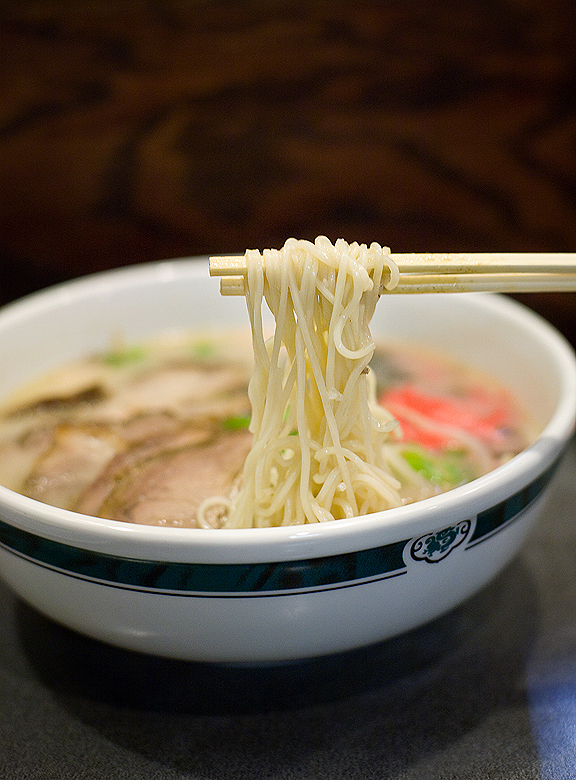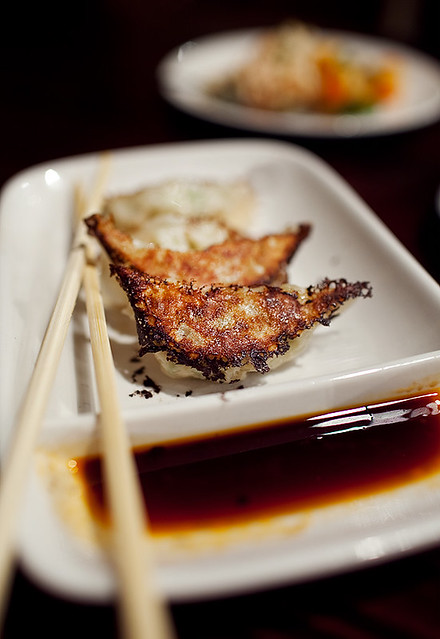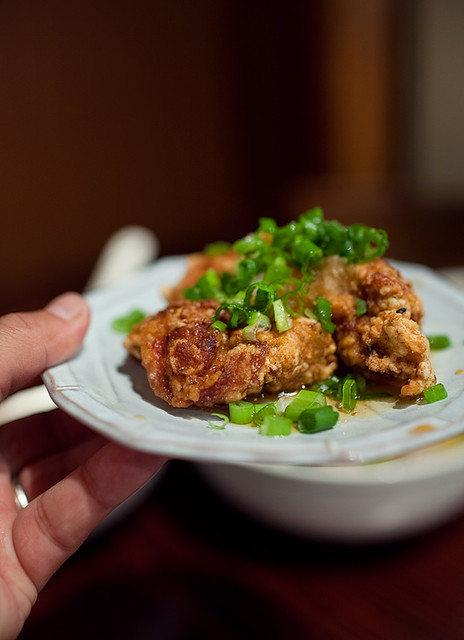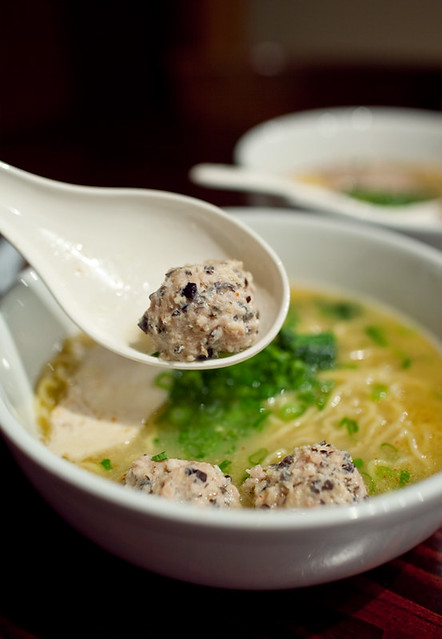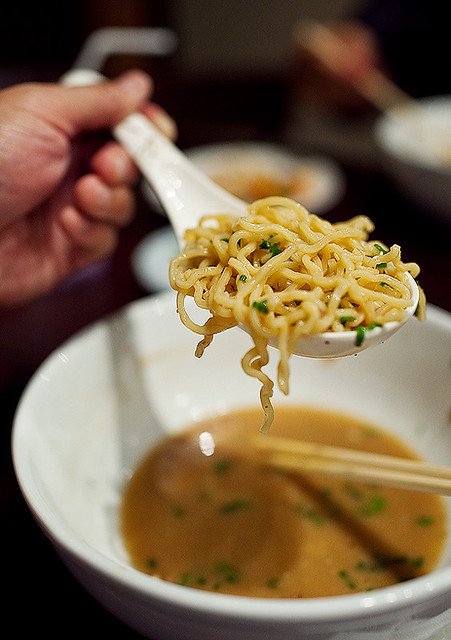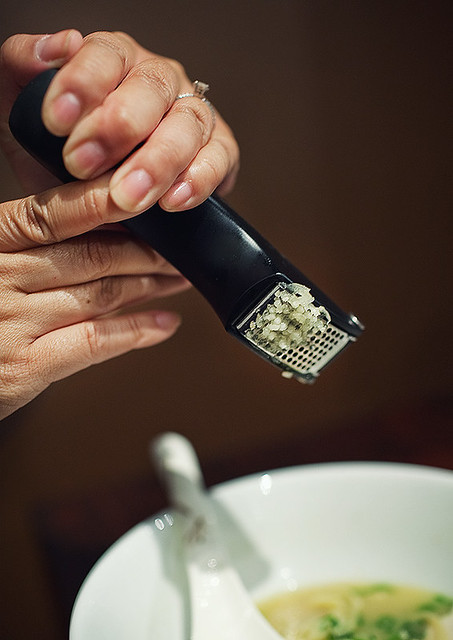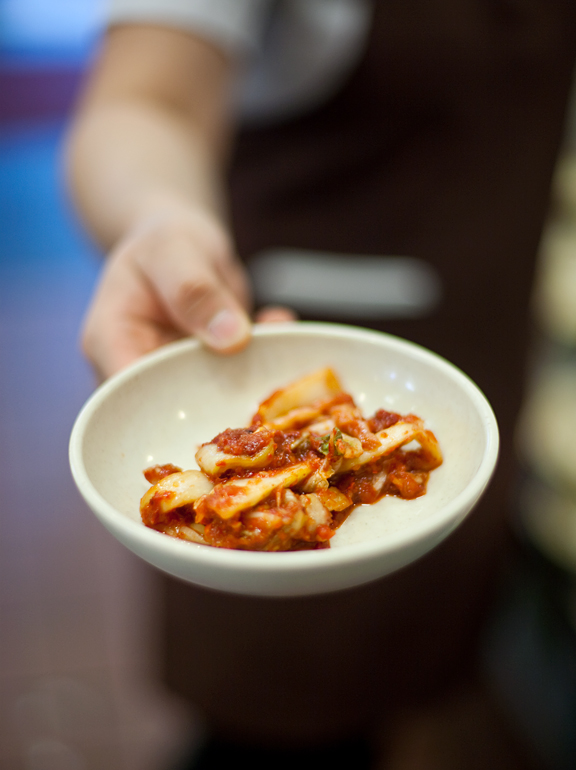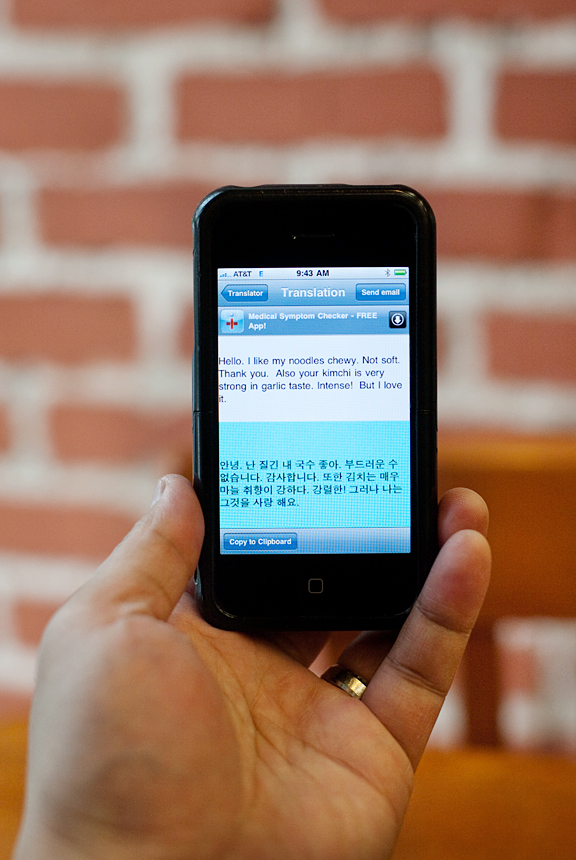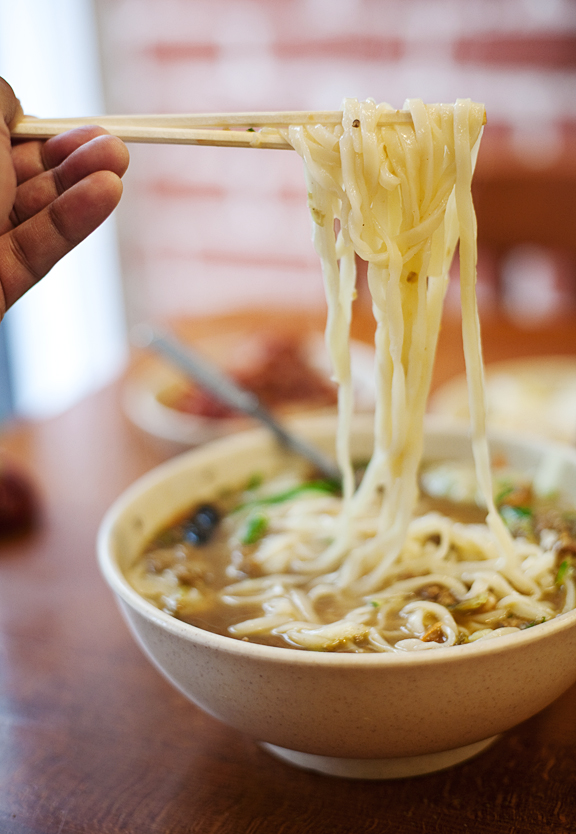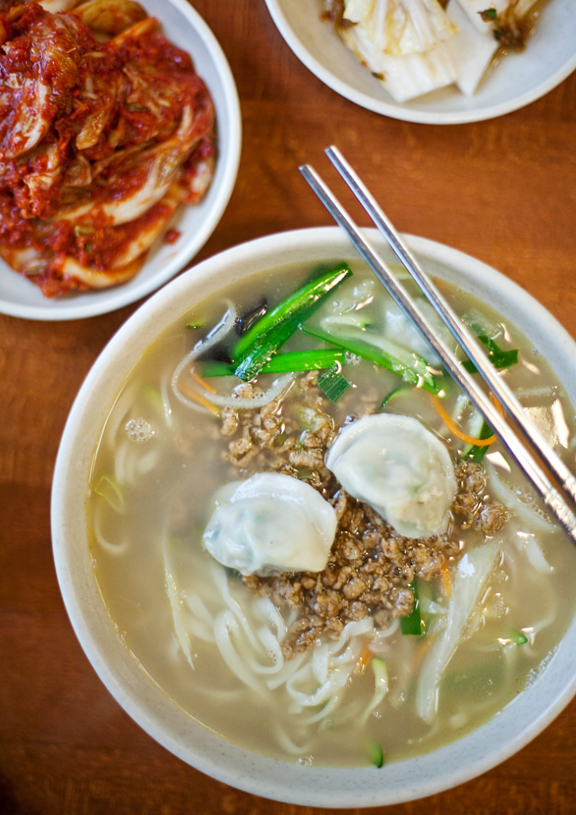Showing posts with label noodles. Show all posts
Showing posts with label noodles. Show all posts
Home » Posts filed under noodles
Eat Drink Style Olympic Noodle, Koreatown - Korean-Style Knife-Cut Noodles
As a noodle enthusiast, I give every cultures's offerings a chance whenever I can. Up until a few years ago, I didn't think Korean food had much to offer outside of their cold noodles (naeng myun), fried vermicelli noodles (jaap chae) and more popular amongst pimple-faced, brace-wearing teenagers, the instant kimchi noodle bowls loaded with MSG. Then I was introduced to Ma Dang Gook Soo and Myung Dong KyoJa, both of which are popular noodle joints in Koreatown. It was the first time I had eaten Korean-style knife-cut noodles and it was pretty good. I lost interest in MDGS pretty quickly because the soup was just too starchy. MDK's style of soup noodles also reminded me a lot of Chinese ground pork noodles (rou zhao and ja jiang mian). The dish itself is tasty when you add all the necessary condiments but the overcooking noodles was sadly consistent and really killed it for me. Korean noodles are good, but in the minor leagues compared to Chinese knife-shaven noodles (dao xiao mian). This style of noodle was done really well at places like Heavy Noodling and Kang Kang Food Court in SGV, and more recently, JTYH Restaurant in Rosemead. But there's a certain simplicity and homeyness to Korean food that I really enjoy. I'm not Korean but I certainly eat a lot of Korean food.
Given the option to spend $12-15 for a lunch in Culver City, I'd rather take El Diez down to Crenshaw for a place almost 1/2 the cost of it – and that's where I've been eating a lot of lunch. The fact that I've been back here nearly 10 times... bringing my wife Jeni, 3-4 coworkers and in the near future, the members of the Le Club de Grub project at work, it is clear that I really do enjoy this place.
You can expect your typical Korean restaurant set-up and decor here. Wood-laminate walls, a TV blaring Korean soap-operas and a large fridge loaded with condiments. The majority of the clientele here during lunch are older Korean businessmen, wearing napkins to shield any oily splash-back from the broth. But what you'll notice here if you pay attention is just how silent it is, with exception to a few loud slurpers. Everyone is pretty busy with their face in the large metal bowls. Always a good sign.
Here's the first reason why I like Olympic Noodle: their kimchi. It's not that bullshit watery, acidic kind from Cosmos jars. It's fresh, pasty, spicy and garlicky kimchi that is made like every few days. If you touch the kimchi with your fingers, you can still feel its pulse. Also, the servers are as nice as your own mother (hopefully). When it's not busy, they'll come and cut up your kimchi, making you a prince instantly for that $7.69 you're spending on their soup noodles – not bad right? AND, peppermint candy for your breath.
Steamed Dumplings
The Chinese make solid dumplings. I never had a huge liking for Korean dumplings because (A) they overstuff their dumplings, (B) don't go beyond meat and green onion filling and (C) I can't for the life of me figure out why a bag of 40 Korean dumplings will cost $12 at the market. And after trying Myung Dong Kyoja's dumplings, which I know is a big Koreatown favorite as well, I think I decided to stay with Chinese dumplings. And then, I find this place thanks to a coworker and I am liking Korean dumplings again. You can order these steamed, boiled or fried but I highly recommend steaming because you'll get the maximum flavor. But either of these will taste good unless you have your dipping sauce. A simple mix of soy sauce, vinegar, red chili paste and a few dashes of sesame oil – you're good.
Portrait of a Dumpling About to Be Eaten, 2009, Oil, Paint, Printed on Canvas
It was steamed perfectly and full of flavor. My coworker and I downed these in like 5 minutes. Note: Korean-style fried dumplings usually mean they are dumped in the fry-o-lator, not pan fried like potstickers or gyoza. Fried is good as well.
Main Event: Chicken Noodle Soup
This is what most people order and it's tasty. You can tell the soup is boiled with bones when it has that muddier color like tonkotsu ramen, which is known for its rich, pork bone broth. They give a lot of chicken actually and boiling it for a while is probably the easiest way to eat a dry-ass piece of chicken breast. The noodles have curves and jagged edges from inconsistent knife-work but have a nice bite to it. On the side, you'll see a red chili powder/scallion paste that you add to the chicken soup noodles. Then there's a soy sauce/scallion "relish" jar too for you to flavor the broth if needed. A few dashes of sesame oil can make it taste pretty good too. I prefer the Anchovy broth noodle soup because it has that nice dashi taste to it. But with first-timers, I always order them the chicken incase the word 'anchovy' makes them run for the hills.
Just a note, one bowl of soup noodles is usually good between two people if you order the dumplings – only costing you $15 total with tax. Actually at Olympic Noodle, I usually see TWO GIRLS, ONE BOWL. K, bad joke – I'm not even going to provide a reference link. If you're in the mood for something homey and tasty, Olympic Noodle will do the trick. Thanks for reading.
Olympic Noodle
4008 W. Olympic Blvd.
Los Angeles, CA 90019
(323) 931-0007
Eat Drink Style Pho Garden, San Francisco - Man vs. Pho: An Actual Survivor of the World's Largest Bowl of Pho
 Man vs. Pho
Man vs. PhoToday, I received an email from a reader by the initials of HB. She had read my posting on Pho Garden up in San Francisco, the proud host of the pho challenge. If you can eat this mammoth bowl of pho, your $22 bowl of pho is FREE. I did not realize just how big this bowl of pho was until HB emailed me these photos. Just look at it. Do the servers need a weightlifting belt just to haul this to the table? I think I see the hooves and horns of the cow in that bowl as well. Worth it?! Not in my opinion. But for an eating-challenger like this gentleman, it's worth the bragging rights and a well-deserved virtual high-five from me. Here's what HB wrote:
"I was witness to my boyfriend Brian completing the Pho Garden challenge last weekend. I originally saw your post with Pho Garden pics and of course had to send him the link since we are pho freaks and he recently discovered the world of eating challenges. He emailed the photos around and issued a challenge to his friends. 2 months later 3 challengers sat down to the huge bowls of boiling pho. Holy cow you should have seen the mixed emotions these guys went through in the span of 60 minutes while eating- fear, happiness, relief, denial, nausea, disgust. My boyfriend Brian was the only one to finish in 47 minutes and I have to admit that I've never been so proud! haha! So thanks for the idea and now this triumph will live on forever for us. Oh yeah, I wanted to mention that Brian said that initially he thought the pho was good, but that he seemed to be slowly blacking out while he ate and cannot remember the taste of a single piece of meat even though he ate 2 pounds. Pretty funny, right? Has this ever happened to you?"
 Fear, happiness, relief, denial, nausea, disgust? Talk about an emotional meal. And no I have never had a euphoric, near-death experience from eating. Well maybe the f'd up shrimp I ate in Brazil that pained me for 3 days and earned me a 60-minute morphine ride at the hospital.
Fear, happiness, relief, denial, nausea, disgust? Talk about an emotional meal. And no I have never had a euphoric, near-death experience from eating. Well maybe the f'd up shrimp I ate in Brazil that pained me for 3 days and earned me a 60-minute morphine ride at the hospital. If you look carefully, the bottom of the bowl says "You did it!!!" Good thing it didn't say something like...
If you look carefully, the bottom of the bowl says "You did it!!!" Good thing it didn't say something like..."Congrats, this was just the appetizer."
"Good job, the hospital is a few blocks down."
Thanks again to HB for the email and congrats to Brian.
Eat Drink Style Ord Noodles and Thaitown Noodles, Hollywood - Mini Bowls of Joy

Just kidding... they aren't THAT small. Just wanted to bring to light, some of my favorite soup noodles from the Thai Town area in Hollywood. When I was writing the Noodle Whore blog, I started out researching the Thai Town area – places like Yai, Sanamluang, Sapp Coffee Shop and Rodded were definitely popular. In a matter of 5 years, my dad (Noodle Whore Sr.) and I have seen Thai Town change quite a bit. A few changes in ownership and new chefs really kept it dynamic. So it's not a wonder that I, maybe you as well, jump around the restaurants a lot in Thai Town. In my opinion, one thing remains true though. Besides the spicy curries, hand-mixed food, soups and stir-fries, the Thais are outstanding at producing tasty soup noodles. And it's why I continue to eat here at least twice a month.
It was only a few years ago that Thai Town introduced their version of a Jack-in-the-Box/Burger King slider, or as they call it Mini Sirloin and Burger Shots. My Dad said that I was being too much of a fat, greedy, over-consuming American because this is how they do it in Asia – smaller bowls. Face it, we all like miniature things. As much as I hold myself back in using the C-word, miniature things are CUTE. And I think the same thing can be said about these smaller bowls of soup noodles – or as I call them, Diet Soup Noodles. It's not that they are healthier in any way, it's just that you get a smaller serving. For anyone that enjoys soup noodles, this is great because you can try more than one type of noodle each time you visit. Or you can be a Debbie-downer-pessimist and see that you're actually spending more money for two miniature bowls than a regular sized bowl. Whatever the case, your stomach will thank you.
Ode to Ord
This place has always been solid. The crowd here is typically younger and the clientele primarily speak Thai. At any time of the day, you can find yourself bobbing your head to Thai R&B slow jams busting out from the mini stereo system here. Ord has also started closing daily at midnight – oh joy.
They have 4-5 different types of noodles you can pick from in the mini $3 bowl category. Not everything is offered in a midget form, just a few. Most people come here for the Crispy Pork & Basil Rice and Thai Boat noodles, but Ord prides itself most on these noodles called hoy khaa. Literally, it means 'dangling feet noodles'. Don't worry, the cooks weren't soaking their feet in your broth, it's a reference to the makeshift-seating at this particular noodle shop along the rivers in Thailand. I believe Ord is the name of the city this family is from. When you go in, look at the photos of the dangling feet and you'll know what they mean. $3.50 for diet bowl, $5 for regular bowl.
Ground Pork, Pork Ball, Dried Shrimp & Pork Liver Soup Noodles (#1 Hoy Kha)
This is a true pork-heavy treat. Nice chunks of ground pork, a toothsome pork ball, slightly-bloody pork liver with your choice of noodles - served dry or with soup. I almost always go with the soup and thin rice noodles. The soup has a nice pork bone base with a sharp sweetness and a bit of tartness to it. There are so many delicious things to pick at and excavate from the bowl. Thinly sliced green beans and fresh bean sprouts are added for texture.
Note: medium spicy is pretty SPICY. I'd go with mild and add your own chili flakes. Also, for some reason, if you order hoy kha with glass noodles, you can't get a small bowl – only a large bowl. Also #2, I sometimes find the regular-sized bowl isn't filling enough, simply add $1 more for noodles.
Recommendation: Thin or thick rice noodles with soup. Egg noodles just don't seem to work well with this.
Thai Boat Noodles (Kuay Tiao Luh)
This is the most common bowl of soup noodles in Thai Town, much like Chinese beef noodle soup in San Gabriel Valley. The soup is made with Thai soy sauce, fish sauce, herbs, spices and of course, beef blood for the rich flavor. I really enjoy their soup, as it has a nice beefiness and vinegar kick to it. Compared to Sapp Coffee Shop's bold kick-in-the-face TBN, this is more on the delicate, sour side. I used to eat at Sapp a lot, but lately, it has become a bit salty for my taste. But they do a great TBN.
Recommendation: Thick rice noodles with soup. Choose from Beef or Pork, both are good.
On the other side of the street and just a few blocks east is another strip mall gem that doesn't get as much attention. We've been coming here for years to this noodle shop run by a mother and daughter. In January '09, the mother retired and sold the business to another woman. My Dad and I still call it "Mama's Noodle shop" though because it's so homey. The space is no bigger than your average dining room/kitchen, seats approximately 20 pigs and really feels like you're eating at someone's house. The chef is pretty much within arm's reach. And they barely have any room to contain their restaurant products. I remember one time having to use the restroom. The place was so small, the cook AND the waitress had to stop cooking and move out of the way just so that I could walk through haha.
On the outside of the restaurant is a giant hint as to what you should order. I want one of these to hang over my fireplace but I think you-know-who would be upset. Nam tok can be translated as 'beef blood' noodle soup. But it doesn't matter, just saying these two words will get you to a happy place. $3 for a diet bowl, $5 for a regular bowl.
You are looking at one quarter of the restaurant.
Here's another soup noodle worth trying. Think TBN with tendon and minus the blood.
Here's the chef in the second quadrant of the restaurant.
Preparing the nam tok noodle soup.
Nam Tok Beef Noodle Soup (Kuay Tiao Nam Tok)
I'm sad that the previous owner is no longer here because she truly made a great bowl of nam tok noodles. Although these are a bit different, I still think it is decent if you don't want to wait at Ord, which can sometimes be crowded. The major difference between this version and Mama's is that they add a lot of fried garlic, fried pork skins (chicharrones) and have a clearer soup. Mama's was way more rich in beef blood, while this is stronger on the five-spice powder flavor. Still, both are good. Meat is cooked perfectly as I love my liver pieces to be more on the bloody side.
Tom Yum Pork Noodle Soup (Kuay Tiao Tom Yum)
I usually order a small bowl of this along with my nam tok noodles. It's nice to have two different flavors going on. Tom Yum, as you're probably familiar with, describes a distinct sour taste in food – almost limey and spicy. The soup noodles here don't employ the same broth, but something way more delicate than its counterpart, tom yum goong. This is served with similar ingredients as Ord's hoi kha, and also includes fish cake, fish ball, fried garlic and fried pork skin. Try this out sometime.
Thanks for reading. Both places are cash only.
Ord Noodles
5401 Hollywood Blvd.
Los Angeles, CA 90027
(323) 468-9302
Monday - Sunday 10am - Midnight
Thaitown Noodles
5136 Hollywood Blvd.
Los Angeles, CA 90027
(323) 667-0934
Monday - Sunday 8am - 8pm
Eat Drink Style Shisen Ramen, Torrance - A Szechuan-Style Ramen Shop
I think my appreciation for ramen came after my friends and I went to Japan for the first time. We weren't particularly hunting for ramen, but more so, let the smells and signage of a ramen shop attract us. And we fell in love. Japan made it really easy for us to find food through one simple principle: cook nothing but delicious food. Every shop we went to was simply solid. From light, salt-based and soy sauce-based soups (shio and shoyu) to thicker-stock soups (tonkotsu), they were all good. For a while, the ramen shops on Sawtelle row represented the ramen capital. And it wasn't until coming back from Japan, that we realized that those noodle shops just didn't cut it. We reminisced and lamented for a while. We tried to find a place that offered a more rich-style broth other than salt and miso paste.
Then came Shin Sen Gumi (Gardena, Costa Mesa & Rosemead) and Daikokuya (Little Tokyo) opened, creating this pork-bone soup craze that changed the Los Angeles ramen scene. Shortly after, a wave of new ramen shops hit the Los Angeles area after 2000, introducing more and more varieties of ramen. Santouka, Asa, California and Gardena ramen to be exact. Our friend Rameniac really helped define the differences in the shops available here and really made ramen a hot topic.
After class, Jeni and I continued our ramen adventures in the South Bay area. We had a really tasty experience at Shigetoshi "Sean" Nakamura's California-cuisine/ramen experiment – in which he combines farmer's market ingredients like heirloom tomatoes and cheese in ramen. A combination that would surely raise the eyebrows of any pre-nisei Japanese, but has somehow got both Jeni and I craving it. And we find ourselves here at about 10 pm – at a ramen shop offering Szechuan-style ramen. Funny when you think of it, since it was the Chinese that inspired Japanese ramen. FYI, ramen means 'pulled noodles', and it's pronounced 'la mian' ( 拉 麺 ).
I was so stoked to try this because we had a similar dining experience in Yokohama, Japan, shortly after visiting the Ramen Museum. Ridiculous, I know. Basically, take your traditional Chinese dishes like BBQ pork, black bean sauce noodles, mabo tofu or sesame paste noodles and dump it on top of noodles and soup... voila Chinese-style ramen. But it's actually more complicated than that as you'll see.
We sat down and took a look at the menu. The main feature was the shisen ramen, which is Japanese for Szechuan. We were about to order from it until we saw tonkotsu and a special ramen called the Garlic Black Shisen which got us wide-eyed. A few months ago, I was at Ippudo Ramen in New York begging the chef to make a 'burnt soy sauce' ramen (kogashi) I had heard about. My friends had just gotten back from Japan and bragged about it - I couldn't take it! I was declined in New York but suddenly reminded of that style of ramen when I saw the Shisen special. One please.
Garlic Black Shisen Ramen ($9.80)
Although it looks like a mini Exxon oil tanker ran into some rocks, this was one promising bowl of noodles. We both took a whiff of the ramen – the smell of fried garlic was marvelous. Thinly-sliced scallions, bamboo shoots and a few pieces of pork... we were ready. The soup was really excellent, but super oily. That's expected out of any tonkotsu-style soup.
They used yellow noodles, which had just the right texture to it. I usually go for medium cooked noodles because I like more bite to it. I am actually craving this bowl of noodles right now. They've had this on special since July and the servers said that they do change frequently. I would go eat this ASAP.
Tonkotsu Chashu ($7.50)
We also ordered the tonkotsu chashu ramen to really gauge the restaurant. We do this all the time with pho restaurants. If the pho isn't any good, chances are, it's not their focus or they really need a new chef. I looked at the broth and kind of hesitated. After eating that Black Garlic ramen, I was a bit greased out. But it was everything but oily, and packed with a strong flavor of pork, salt and a lot of ginger. I even dumped in some of the pureed garlic offered by the restaurant. This was really good. Except for...
the overcooked noodles. Aye. It could have been a stellar bowl.
But to make up for that, Shisen Ramen is quite generous with the chashu portions. It was almost too much for me since the pieces were pretty fatty.
I also noticed in the chashu photo, an uncanny resemblance to Scarecrow in Batman Begins. Not the most beautiful photo of chashu, but I promise it is very palatable.
We also ordered gyoza and paiko for appetizers (not pictured). The gyoza (in Chinese 'jiao zhi' or 'gao jee') were tiny as hell, but fried beautifully. You know you're eating a good gyoza when you have that tiny crunch from the crisped up wrapper – something the Japanese are masters at making. The paiko here (in Chinese 'pai gwut' or 'pai gu') are very similar to the fried pork chops sold in Taiwanese joints, but nothing comparable to it. They were fried nicely with a nice dash of five-spice powder and served with a Sriracha-based dipping sauce.
I am already thinking about my next meal here. Thanks for reading and hope you enjoy.
Shisen Ramen
1730 Sepulveda Blvd. #6
Torrance, CA 90501
(310) 534-1698
Eat Drink Style Ramen Jinya, Studio City - A Tasty Bowl of Lost in Translation
If you remember the opening scene of Lost in Translation, you can see a red-eyed, groggy Bill Murray wake up in a cab. The amazing array of Japanese characters in neon light form reflecting off the windows of the cab. Cut after cut of city life and a blank stare provide us with the confusion Bill experiences. For the whole movie, everything he was accustomed to, interactions, mannerisms and customs were either flipped upside down or thrown out the door. And it was the same way I felt when I had first arrived in Japan. It was already the evening when we landed in Narita International. From there, we cabbed it into the city and it was just like the scenes in Lost in Translation. Lights - of every possible hue. Signage - working every single one of your sensory glands. Black-haired people - walking around aimlessly. All of this happening within a tightly packed concrete jungle. This was the system known as Tokyo.
Being tourists in Tokyo was a challenge. Everything was written in Japanese and no one spoke English. If there was English signage, it probably didn't make any sense. Try finding directions in the metro station and you'll be sure to spend more time than you need there. You may know that more comically as Engrish. If it were not for one of our friends that spoke minimal Japanese or the Chinese characters in Japanese (kanji) we might as well have just followed a tour book. But when it comes to eating, I never found it difficult to find good food. There are photos and drawings everywhere. Their posted outside businesses, all over the window and even have employees running up to you to reel you in. There's also the wonderful art of plastic food modeling in Japan known as shokuhin sanpuru which is more often than not, a clear indication of what you'll be eating. In Tokyo, after a long night of you know what, I found myself completely fueled by sake and Sapporo, running by a restaurant with the food models sitting on a table, not enclosed in a case, and awarding myself with a plate of plastic tonkatsu for a souvenir. Oops. To that restaurant in Tokyo, sorry, I still have it if you want it back. Read more about Japanese food modeling here.
In Japan, the worst food there is probably better than any Japanese food you'll eat in your neighborhood. It's true, the standards are so high there for a culture that drools over small details. It was because of the simple enticement by large food photos and high standards that we were able to eat solid ramen at every ramen shop. And I loved that. You didn't have to log on to a food forum, Yelp or a tour book to find good food, it was really the food that found you. I can still remember the last bowl I ate in Tokyo. It wasn't a very busy shop and it was the kind of restaurant that you ordered the food from a machine, which then printed the orders in the kitchen. In less than 10 minutes, a server brought your piping bowl of whatever ramen – it was divine. We were indeed lost in translation, but frolicking in the joy and art of Japanese soup noodles.
This was 2006, and since then, I've only found a few places in Los Angeles and New York that were worth considering, "solid ramen". I do like Santouka from time to time, but I feel guilty eating such a rich broth. I like Asa Ramen for its fatback toppings, but that too can be much. Ippudo Ramen and Ramen Setagaya in New York are super tasty, but I don't live in New York! But good news comes to me when I get an instant message from the Rameniac, and usually it sounds like this:
"Hey, I found a new ramen joint that opened up."
This time, I'm brought to Studio City, a satellite of Japanese food culture in Los Angeles. During the 80s, a lot of sushi shops were popping up for the wealthy movie industry folks and even now, Ventura Blvd. is peppered with here and there Japanese joints. Ramen Jinya is located in another one of the millions of Valley strip malls next to good old Marshalls. One look from the outside and you wouldn't think much, but with an ex-Santouka ramen chef leading the charge and backing from Takahashi Tomonori, a successful restaurateur that operates 7+ establishments under his La Brea Dining brand, I think I've found myself a piping-hot, bowl of Lost in Translation.
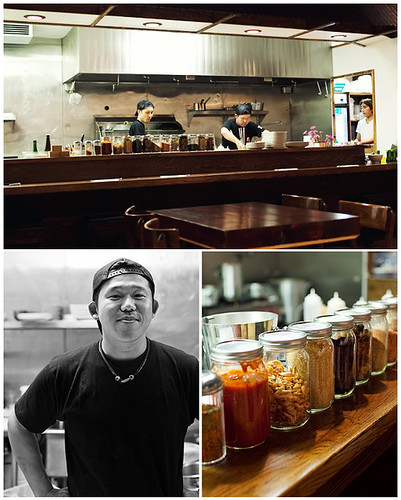
Like California Ramen in Torrance, Chef Daisuke Ueda ("Daice") offers a Californian twist to the menu with fresh salads that include corn, broccoli and potatoes. But that's the least of our interests - we want to get into the meat of everything!
Gyoza
For $12.50, Ramen Jinya offers a happy meal consisting of a small salad, appetizer of choice (gyoza, fried chicken karaage, etc.) and the ramen of your choice. The skins were very thin on these and as you can tell fried beautifully. I love when you get that caramelized sauce "webbing" on the bottom of gyoza. The sauce was a soy sauce, vinegar, sugar and chili oil mix. I think they may have been over-steamed because the gyoza wrapper was slightly soggy. Gyoza has to be served and eaten right away.
Fried Chicken (Karaage)
This is one of my most favorite things to order at any izakaya. These were beautifully fried and marinated well. I hate when karaage has too much batter or the chicken is too dry. This is strictly a dark meat dish. If you're in Little Tokyo, try out Chin Ma Ya's karaage... it's probably one of my favorites in Los Angeles. This was served with ponzu sauce.
Fried Garlic & Bonito Shoyu Tonkotsu Ramen
With a name that long, it should be a solid dish. This was the special at the time of the grand opening and what Rickmond was telling me about all day long. To be exact, these our his exact words:
"What I did order on my initial visit was simply the special of the day, a delightfully authentic and hitherto rare-outside-of-Japan take on Tokyo gyoukai ramen, with a dashi and gyofun fish powder-infused shoyu tonkotsu soup and a topping of marinated and grilled bonito and garlic flakes."
He had me at "garlic flakes". I honestly felt "Tokyo" when I saw that bowl. Moist rolled-up chashu, golden noodles, scallions, an aromatic brown broth with a ladle so large that it could be used as a shoehorn. If you're shopping for some shoes at Marshall's next door, I'm sure Daice won't mind if you borrow the ladles.
I first tried the broth and it was super tasty. I could taste the nice bitterness from fried garlic with the soy sauce and subtle bonito-flavored broth. The noodles were nice but I would have preferred them even more al-dente. And the, the chashu, mmm... nice and melty. The egg although was a bit too mushy. I was hoping for molten lava yolk action.
Jinya's Chicken Ramen
My favorite wife ordered the namesake house special. I was surprised that Chef Daice would select the chicken ramen as the captain of the ship. I didn't think much of this until I took a sip of that broth. Beautiful. It was so homey and reminded me of a delicious version of Campbell's chicken noodle soup minus the sodium. Chef Daice boils chicken bones for 8 hours... just long enough to add a subtle stickiness to the broth much like tonkotsu broth. I could taste some ginger and garlic in the broth.
This was served with two chicken meatballs (tsukune) that had a decent amount of wood-ear mushrooms and a super moist piece of chicken breast. I would order this next time I go, it's seriously tasty.
That shoehorn is no joke. It makes Ippudo Ramen's spoons like miniscule.
Garlic Injection
If you're a garlic head, then Chef Daice will let you inject as much fresh garlic as you want into your bowl of ramen for a nice spice kick.
Our friend JK, another satisfied slurping customer.
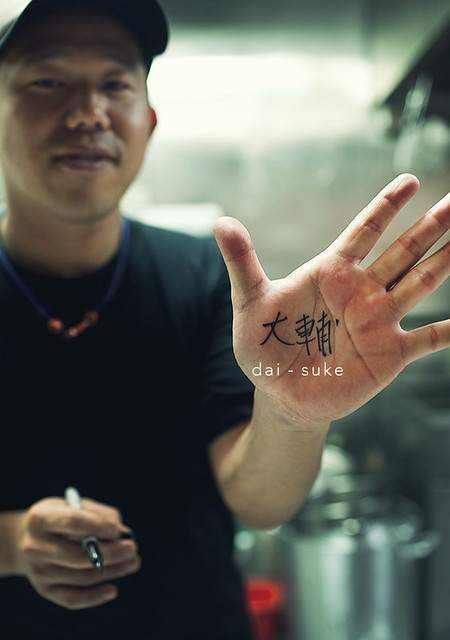
Ramen Jinya has only been open for a week and I have a feeling it will do pretty well. Although out of the way, you'll be glad to know there's a Marshall's next door - two birds with one stone. Admit it, we all shopped there many times in our lives. On top of the quality of the food, both Chef Daice and Takahashi Tomonori are more than welcoming and friendly. This just may be your closest taste of Tokyo without enduring the 12 hour flight, jet lag, sensory overload and confusion. By the way, we'll be running up and down Japan next week for food! Thanks for reading and of course to Rameniac for fulfilling our ramen cravings.
Ramen Jinya
11239 Ventura Blvd.
Studio City, CA 91604
(818) 980-3977
www.jinya-la.com/ramen
Ramen Jinya
11239 Ventura Blvd.
Studio City, CA 91604
(818) 980-3977
www.jinya-la.com/ramen
Eat Drink Style Myung Dong Kyoja, Koreatown - Garlic Warfare in Koreatown
If you think about it, garlic is probably the one ingredient that is prevalent in almost every culture's food. Revered for its healing and medicinal qualities, this member of the onion family, along with leeks, shallots and chives, was used once as currency, for healing wounds, ingested for spiritual reasons and for warding pale, creepy people with fangs. But for those that enjoy food, we all know that garlic is a major component in cooking and repelling a hot date during dinner. Whether its sauteed or even eaten raw, garlic can take a dish to higher levels. But to what level specifically?
I don't know, but I have a feeling the Koreans may have an answer. Why Korea? Over Spain, Italy and America, Koreans consume more garlic per capita than anyone else. Just how much? Americans eat an average of 2.5 lbs. of garlic a year... Koreans – 22 lbs. a year. 22 lbs. of garlic in a bag can knock you out if it was swung at you with enough force. I've always known that Koreans use copious amounts of garlic, along with sesame oil and red chilis, but this as you will learn very soon, is a complete understatement. For many years already, garlic warfare is happening in Koreatown. And you probably didn't know that it was happening at a place on Wilshire and Harvard.
I first came to Myung Dong Kyoja when I was searching for one of my favorite korean dishes, kal gook soo. Kal gook soo literally means "knife-cut noodles" and it is basically a soup noodle dish with various toppings and broth flavorings. The most popular being chicken noodle soup (dahk kal gook soo) and anchovy-flavored noodle soup (myeol chi kal gook soo) offered at Koreatown places like Ma Dang Gook Soo and Olympic Noodle. Unlike a proper bowl of pho or Chinese beef noodle soup, this dish is much more simple, comforting and homey. The soup at first may seem light in flavor, but the simple addition of some scallion/chili/soy sauce relish and chili powder and you're good to go.
When you first walk in here, almost instantly, you will be hit with an invisible fist of garlic. It is at the entrance of the door that you have the option of saving yourself from sweating out garlic for the rest of the day, or taking your palate on a test drive through Garlicville. Go for the latter if you're true garlic-head.
And once you've ordered your food, the server comes out with a small portion of kimchi as seen above. You're probably wondering why so little is given, but it's more than you'll need. I can promise you that every piece of cabbage packs a decent amount of minced garlic. At first bite, you'll know what I'm talking about. I think I ate about three pieces before my tongue started to sting a little from the fresh, fieriness of the minced garlic cloves. So fiery that when you drink some water to abate the pleasurable pain, you can feel a sort of numbness in the tongue. And I love it. It's almost like you're eating minced garlic with a side of red chili and cabbage.
Look at that, it is a crater of garlic. Just standing over this holding pot, I was hit with major garlic fumes. Insane!
If you can handle the hazing on the tongue, they'd be more than glad to serve you with another 1-2 punch. The servers come by with their kimchi pitcher and tongs. Intense!
In addition to the garlic freak show, there are a few things that are worth eating at MDKJ. The steamed dumplings (goon man doo) at first appear to be Korean cousins of the widely-adored Chinese xiao long bao, soupy pork dumplings. But they are nowhere nearly as juicy as they are. The dumplings themselves are plump due to a heavy vegetable to meat ratio. They are steamed in a plastic basket and are indeed pretty decent. But I prefer the well-balance boiled dumplings found at places like Dumpling 10053, Dean Sin World and Lu Noodle House. Anyway, a simple mixture of a Korean condiment and vinegar and you're good to go.
There's also MDKJ's version of kal gook soo, which tastes even better once you add the Korean flavoring condiment and maybe a dash of vinegar. The thing I've noticed with Korean soup noodles is that they cook the noodles a little too long for my taste. I enjoy a toothsome, notable al-dente-ness in every bite. So I highly recommend ordering your noodles a bit harder. Problem is if you're non-Korean like me, communicating that is a bit difficult.
But thanks to my trusty Translator app for my iPhone, I can get from point A to B. I always get a kick out of seeing their reaction because this Translator app is so literal, but they get the idea. I said: "Hello. I like my noodles chewy. Not soft. Thank you. Also your kimchi is very strong in garlic taste. Intense! But I love it."
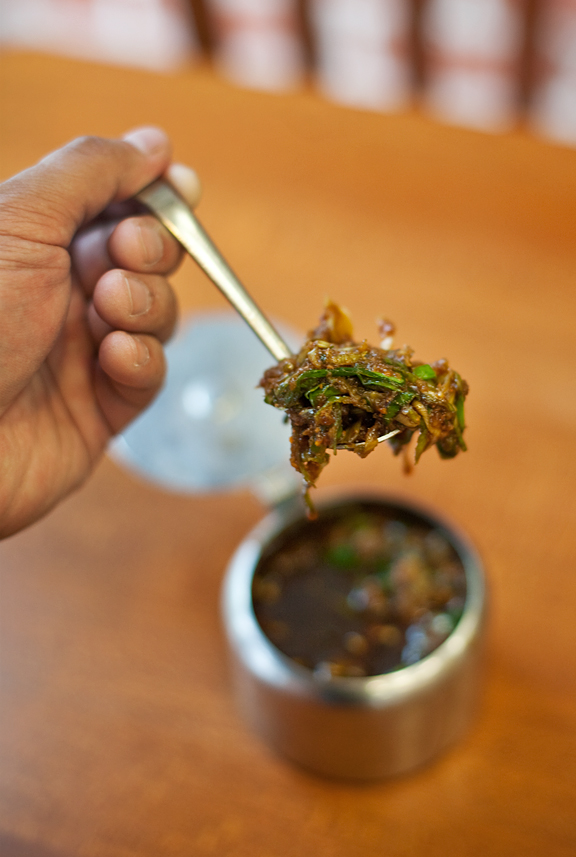
If the garlic kimchi isn't holding up to your garlic expectations, you need to use this relish consisting of soy sauce, minced garlic, scallions and a type of mild korean pepper that has a taste similar to bell peppers and slight spice kick from shishito peppers. I love this sauce. Add 2-3 big scoops of this sauce into your kal gook soo soup noodles and you're set. Like I said before, the soup can be a little too plain without any sauce, so this is what is used to flavor your dish. I like my soup noodles with a touch of vinegar to cut through that muddy garlic tone.
Myung Dong Kyoja Kal Gook Soo
The version served here is much different than what you're probably used to. Soup noodles are served in a slightly starchy broth from the noodle runoff. It's topped with a simple stir fry of ground meat, zuccini, carrots, onions and 3-4 mini dumplings that I really enjoy. If you like the mini dumplings, you can order them straight up with soup and nothing else. Win.
This is what I call a happy meal. The surprise gift is a fiery mouth of garlic.
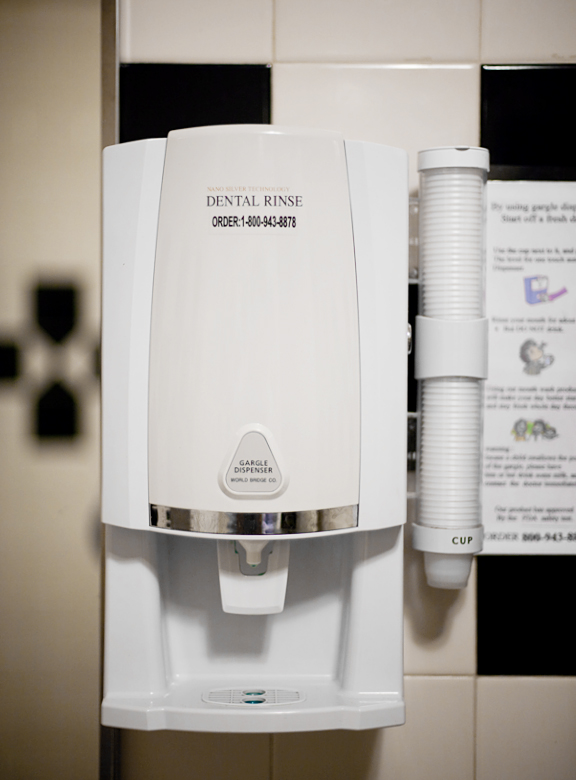
I wasn't kidding when I said there is garlic warfare happening in Koreatown. They've even provided you with a fancy gargling machine in the restroom, the Garlic Kimchi-a-tor 5000. I took a shot of the gargling liquid and it did nothing for me but create this minty garlic taste that seemed to never go away. Don't say I didn't warn you about the garlic. Enjoy and thanks for reading!
Myung Dong Kyoja
3630 Wilshire Blvd. (c/o Harvard)
Los Angeles, CA 90010
(213) 385-7789
Myung Dong Kyoja
3630 Wilshire Blvd. (c/o Harvard)
Los Angeles, CA 90010
(213) 385-7789
Subscribe to:
Comments (Atom)
